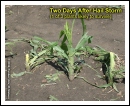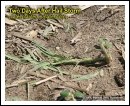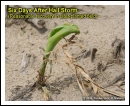




Published June 2006 (Rev. May 2007)

Recovery From Hail Damage
URL: http://www.kingcorn.org/news/timeless/HailDamageYoungCornGallery.html
R.L. (Bob) Nielsen
Agronomy Dept., Purdue Univ.
West Lafayette, IN 47907-2054
Email address:
The following images were taken two and six days following an early June hailstorm in northwest Indiana in 2006. The images are from two fields located within a mile from each other, but were planted on different dates.
The damage sustained in the earlier planted field was a bit more dramatic simply because the plants were older and bigger (five to six-leaf collar stage). However, the damage that occurred on the smaller plants of the later planted field was probably more severe because a higher percentage of the plants were demolished down to the soil surface.
Nevertheless, recovery from hail damage was encouraging in both fields from the first day I looked at the plants (two days after the storm) to the second time (six days after the storm). The lessons from these images are 1) young corn can recover from fairly significant above-ground damage and 2) assessing the consequences of such damage is easier to do if you have the patience to leave the field alone for five or six days.
See the more complete article on hail damage that accompanies this photo gallery.
Click on image to open a larger version. To close popup window, click on larger image.
Gallery 1. Earlier planted field, about V5 to V6 at time of hailstorm, images taken two days after storm.
Click on image to open a larger version. To close popup window, click on larger image.
Gallery 2. Earlier planted field, about V5 to V6 at time of hailstorm, images taken six days after storm.
Click on image to open a larger version. To close popup window, click on larger image.
Gallery 3. Later planted field, about V3 to V4 at time of hailstorm, images taken two days after storm.
Click on image to open a larger version. To close popup window, click on larger image.
Gallery 4. Later planted field, about V3 to V4 at time of hailstorm, images taken six days after storm.
Related References
Nielsen, R.L. (Bob). 2007. Recovery From Hail Damage to Young Corn. Corny News Network, Purdue Univ. [On-Line]. Available at http://www.kingcorn.org/news/timeless/HailDamageYoungCorn.html. (URL verified 5/27/07).

























